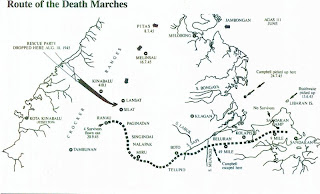 |
| (Click to enlarge) |
During the early 1870s, the east coast of Sabah was under control of the Sultan of Sulu, who also ruled what is now the southern Philippines. The first European settlement in the area was founded by Captain William Schuck, a Scottish, but when Schuck got himself an island around the controlled coast of Sultan of Sulu, William Clarke Cowie, a gun smuggler from Glasgow, replacing himself over Schuck, who then received permission from the Sultan to establish a small trading base. Cowie called his settlement as Sandakan, which in (Sulu) language means "the place that was pawned", but it soon came to be known as "Kampung German" after the large number of Germans who also set up posts there. The settlement was part of the lease Austro-Hungarian consul Baron von Overbeck acquired from the Sultan of Sulu, Sultan Jamal Ui Alam in 1878, which according to the lease, the width upon the concession that von Overbeck acquired were starting from Sungai Sibuco (or known as Sg. Sibuga nowadays) up until the Sungai Padasan's province. During and according to the concession made, von Overbeck will paid $5000 per year towards the Sultan of Sulu and was declared as the Dato Bendahara as well as The King of Sandakan. Baron von Overdeck decided to entrust a number of English officers that he certainly trusted to administrate and took control of his areas of province. One of the trusted officer was the new British Resident, William Burges Pryer. Pryer was most acknowledge as the administrator in which introduced a law known as The Law of Trading's Taxes as a way to avoid any excessive exploitation of trading activities being made. Pryer came to manage and solved a lot of problems such as pirates' attacks, which subsequently attracted the foreign traders to visited the new town. While the Kampung German made a fast development, its actually encountered in a fire due to a carelessness of a resident named, Sabtu. The whole area of Kampung German are burnt down including Pryer own house. The incident caused Pryer and the residents of Kampung German to move to (what is now called) Buli Sim Sim on 18 June 1879. He named his new settlement Elopura, which means Beautiful City. A few years later, the name reverted back to Sandakan. The name Elopura still refers to a Sabah state constituency in Sandakan.
In 1883, the capital of the British North Borneo Company was moved from Kudat to Sandakan. In the mid-1930s, Sandakan's timber export reached the record figure of 180,000 cubic meters, making it the largest timber-exporting port of tropical hardwood in the world. At the height of the timber boom, Sandakan boasted that it had the highest concentration of millionaires anywhere on Earth.
 |
| (Click to enlarge) |
The Japanese occupation of Sandakan during World War II began on 19 January 1942 and lasted until a brigade of the Australian 9th Division liberated it on 19 October 1945. The Japanese administration restored the name Elopura for the town. One of the atrocities of World War II was the Sandakan Death Marches, when Japanese soldiers decided to move about 2,400 prisoners of war in Sandakan 260 km (160 miles) inland to the town of Ranau. The prisoners who did not die en route to Ranau were crammed into unsanitary huts; most of those survivors either died from dysentery or were killed by prison guards. When the war ended, Sandakan was totally destroyed, partly from the Allied bombings and partly by the Japanese. As a result, when North Borneo became a British Crown Colony in 1946, the capital was shifted to Jesselton, now known as Kota Kinabalu, (often just called 'KK' locally).
 |
| Sandakan in 50s and 60s (Click to enlarge) |
Sandakan remains Sabah's second most important port, after Kota Kinabalu. The port is important for palm oil, tobacco, cocoa, coffee, manila hemp and sago exports. Sandakan is also one of the most bustling towns in East Malaysia. The once dominant timber industry is now relatively small. It is likely tourism will become increasingly important to the town's future.
 |
| Click to enlarge |
In recent years, businesses have shifted their operations away from the town centre to the suburbs (Bandar Ramai-Ramai, Bandar Leila, Bandar Nam Tung, Bandar Maju, Bandar Kim Fung, Bandar Pasaraya, Bandar Letat, Bandar Indah Jaya, Bandar Utama, Bandar Perdana, Bandar Labuk Jaya, Bandar Sibuga Jaya, etc.) due to the presence of significant illegal immigrants in the town centre. In January 2003, the Sandakan Harbour Square, an urban renewal project, was launched in an attempt to revive the town centre as the commercial hub in Sandakan. It will feature extra shoplots, a new central market and fish market, a shopping mall (Sandakan Harbour Mall), and hotels. It is to be built in four separate phases and is due for completion in 2011.




Dear Cikgu
ReplyDeleteThank you very much for your very interesting Sandakan blog. I would just like to add to your research:
1) The man who established Kampung German in 1873 was Captain Herman Leopold Shuck. 2) William was the fourth of 5 sons who lived in Jolo. 3) With a name like Shuck, the Captain is actually German and not Scottish. 4) The trading post in Sandakan Bay could have been called 'Kampung German' because it was established/founded by a German.
There are still Schuck descendants living today.
Regards Lala
References:
a) Captain Herman Leopold Schück:
The saga of a German sea captain in 19th century Sulu-Sulawesi seas By Michael Schuck Montemayor (2005)
b)Article: Sulu and Germany in the late 19th century by Volker Schult (2000) ojs.philippinestudies.net/index.php/ps/article/download/439/443